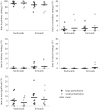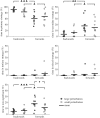Balance control strategies during perturbed and unperturbed balance in standing and handstand
- PMID: 28791131
- PMCID: PMC5541526
- DOI: 10.1098/rsos.161018
Balance control strategies during perturbed and unperturbed balance in standing and handstand
Abstract
Insights into sensorimotor control of balance were examined by the assessment of perturbed and unperturbed balance in standing and handstand postures. During perturbed and unperturbed balance in standing, the most prevalent control strategy was an ankle strategy, which was employed for more than 90% of the time in balance. During perturbed and unperturbed balance in handstand, the most prevalent control strategy was a wrist strategy, which was employed for more than 75% of the time in balance. In both postures, these strategies may be described as a single segment inverted pendulum control strategy, where the multi-segment system is controlled by torque about the most inferior joint with compensatory torques about all superior joints acting in the same direction to maintain a fixed orientation between superior segments. In contrast to previous literature, surprisingly little time was spent in a mixed strategy, representing less than 1% of time in standing balance and approximately 2% of time in handstand balance. Findings indicate that although the central nervous system may employ a number of control strategies during a trial, these strategies are employed individually rather than simultaneously.
Keywords: ankle strategy; postural control; wrist strategy.
Conflict of interest statement
We declare we have no competing interests.
Figures






References
-
- Bardy BG, Oullier O, Lagarde J, Stoffregen TA. 2007. On perturbation and pattern coexistence in postural coordination dynamics. J. Mot. Behav. 39, 326–334. (doi:10.3200/JMBR.39.4.326-336) - DOI - PubMed
-
- Nashner LM, McCollum G. 1985. The organization of human postural movements: a formal basis and experimental synthesis. Behav. Brain Sci. 8, 135–172. (doi:10.1017/S0140525X00020008) - DOI
-
- Horak FB, Nashner LM. 1986. Central programming of postural movements: adaptation to altered support-surface configurations. J. Neurophysiol. 6, 1369–1381. - PubMed
-
- Horak FB, Henry SM, Shumway-Cook A. 1997. Postural perturbations: new insights for treatment of balance disorders. Phys. Ther. 77, 517–533. (doi:10.1093/ptj/77.5.517) - DOI - PubMed
-
- Nashner LM, Woollacott M, Tuma G. 1979. Organization of rapid responses to postural and locomotor-like pertubrations of standing man. Exp. Brain Res. 36, 463–476. (doi:10.1007/BF00238516) - DOI - PubMed
Associated data
LinkOut - more resources
Full Text Sources
Other Literature Sources
